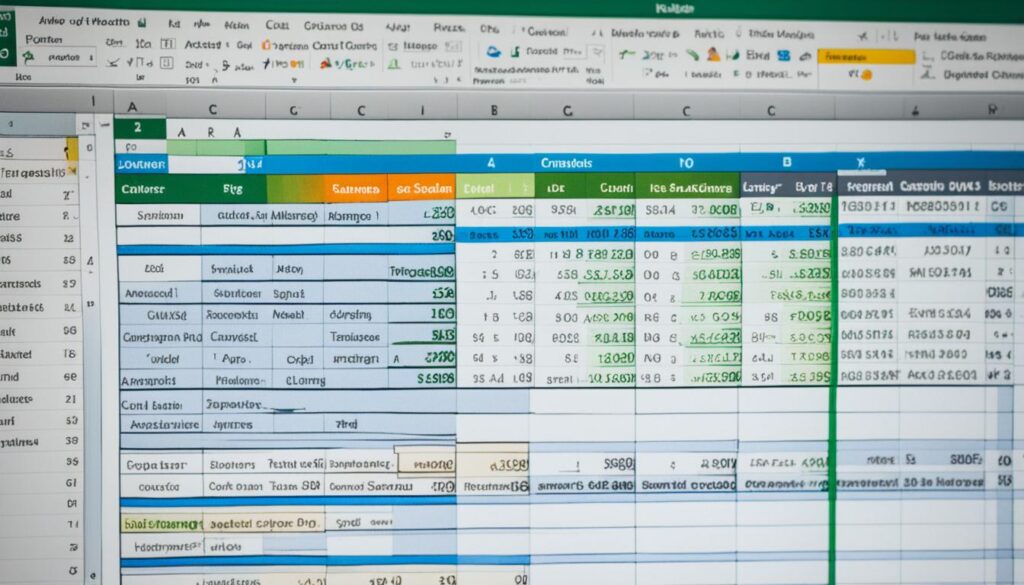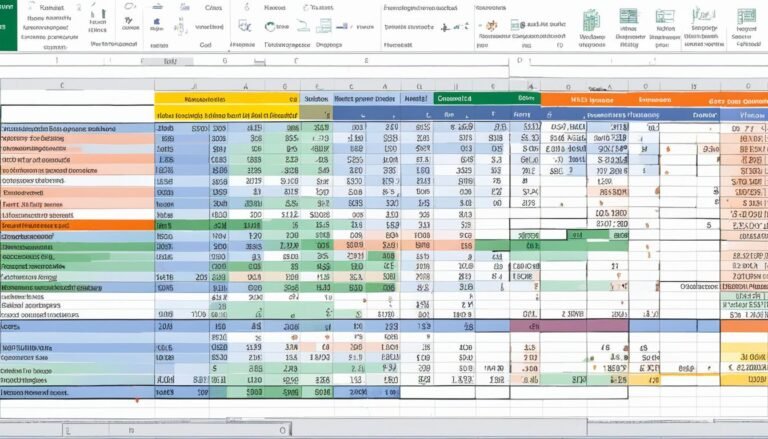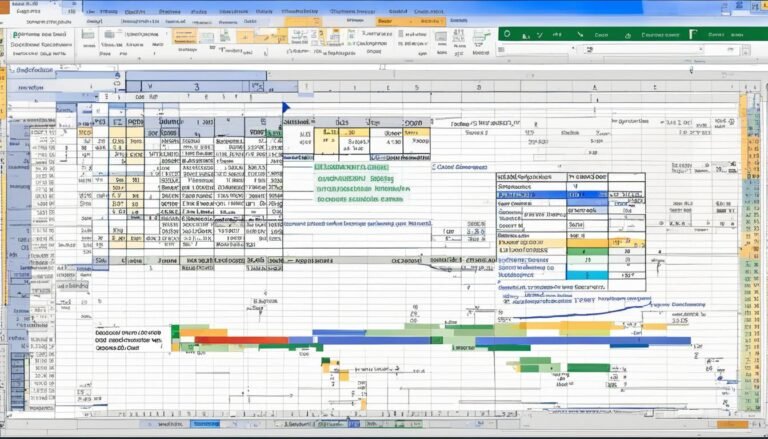Excel Drop Down List: Create and Manage Easily
Being skilled in Excel for over 12 years, I’ve taught businesses and people how to use Excel. I’ve learned that drop down lists are very helpful. They make it easier to enter data and keep things the same on different sheets. An excel drop down list makes a list of choices in a cell. This way, entering data becomes quicker and more precise.
Start by organizing your list of items. It’s best to do this in an Excel table. Using a table is smart. It means any choice lists or lookup lists will update on their own when you change the table.
Key Takeaways
- Drop down lists in Excel simplify data entry and ensure consistency.
- Organizing list items in a table format is recommended for easy management.
- Converting data to a table ensures automatic updates to linked drop downs.
- Tables make it easy to add, remove, or edit items in data validation drop downs.
- Setting up drop downs properly enhances accuracy and user experience.
Introduction to Excel Drop Down Lists
I’ve been teaching Excel drop down lists for more than 12 years. They are amazing for making data input easier and reducing mistakes. With Excel drop down lists, you can make drop down menus for quick data entry.
Excel drop down lists ensure data consistency across your spreadsheets, streamlining workflows and enhancing productivity.
Imagine making data entry forms or surveys that are simple to fill out. This is what drop down lists can help you do in Excel. They not only make entering data easy but also cut down on mistakes. This keeps your data clean for analysis.
Now, let’s dive into how you can use Excel drop down lists to the max. We’ll cover everything from the basics to more complex features like dependent lists. You’ll learn how to enhance your Excel work with these tools.
Preparing Data for Drop Down List
In my 12 years as an Excel expert, I’ve realized organizing your data comes first. Before making choice lists, turn your data into an Excel table first. This step is key.
Converting Data to an Excel Table
Placing your data in a table makes working with drop down lists simpler. To do this, select any cell in the data and hit Ctrl+T. Excel will change the range into a table immediately.
Sorting Data in the Table
In a table format, sorting is wise. It helps find options in drop down lists quickly. Use Excel’s sort and filter tools in the ribbon to do this.
Simple steps like these matter. By organizing your data, you make using drop down lists and dependent drop down lists easy. This boosts efficiency and accuracy in Excel a lot.
Creating a Drop Down List
With over 12 years in Excel, I see how drop down lists make data entry easier. They keep things consistent on your sheets. Let me show you how it’s done with a few steps.
Selecting the Cell for Drop Down
Start by picking the cell for your drop down menu. You can choose just one cell or many, depending on your needs.
Using Data Validation
Next, go to the Data tab and hit ‘Data Validation’. This takes you to a box where you set up your drop down list rules.
Allowing List as Data Source
In the box, choose ‘List’ from the ‘Allow’ menu. This option lets you use a fixed list of choices in your dropdown control.
Specifying Source Range
Here’s the key part – choosing your list’s source. You can type your choices, separating them with commas. Or, pick a range that includes your list from your sheet.
Choosing a range from a table? Leave out the header rows to keep things neat. By selecting the right cells, Excel will fill in your list for you.
Now your drop down list in Excel is set up. This feature, driven by data validation, will streamline how you enter and check data, for better accuracy.
Customizing Drop Down List Options
After more than 12 years working with Excel, I’ve seen how useful data validation and choice lists can be. They let you control drop down list behavior. With these, you can decide what kind of data to allow in your drop down cells.
Allowing Blank Cells
You can choose to allow or not allow blank entries in your drop down cells. Usually, Excel lets you use blank values. But, if you want to require users to pick something, you can turn off the ‘Ignore blank’ option.
Enabling In-Cell Dropdown
‘In-cell dropdown’ is another cool feature. It puts the drop down list right in the cell. This way, users can easily see and select choices. It makes using form controls and data entry sheets a lot better.
You can customize how your drop down list works for your needs. Features like allowing blanks or showing the list in-cell are very handy. When you add data validation rules and VBA macros, drop down choice lists become really powerful. You can use them to build applications that are easy to use.
Adding Input and Error Messages
When you work with drop down menus in Excel, adding input and error messages can make a big difference. These features help users understand what’s required, making data validation smoother. They also improve how users interact with your form controls.
Showing Input Message on Cell Selection
With the Input Message, you can show a helpful hint or tooltip when a drop down menu cell is clicked. It’s great for giving users clear instructions or reminding them of what they need to do. You get to set the message, which should explain any important details about data validation rules for that cell.
Displaying Error Alert for Invalid Data
Excel also lets you create an Error Alert. This alert pops up when someone tries to input data that’s not in the drop down menu’s lookup list. It stops wrong or invalid entries, which helps keep your data accurate. You can write a custom message to explain the problem and guide the user to correct options in the drop down menu.
With these message tools, Excel becomes far more friendly and intuitive. The Input Messages help users understand what’s needed, and the Error Alerts stop bad data input. This all leads to better data and a smoother work process.
Managing Drop Down Lists
With my 12 years as an MS Excel expert, I’ve learned a lot. Using an Excel table as your excel drop down list source makes things easy. Excel makes updates for you. This keeps your choice lists and lookup lists up-to-date.
Editing Table-Based Drop Downs
Editing table-based drop downs is straightforward. To change your list, just edit the table. Excel will refresh all linked lists, making sure the info is always current.
Adding New Items
It’s simple to make your list longer. Just add the new item to the end of the table. Excel will update all drop downs to include your new item.
Removing Existing Items
If you want to take things off the list, it’s easy. Click Delete on the item in the table or right-click to remove it. The change will show up right away in all lists.
Advanced Drop Down List Features
I’ve worked with Excel for more than 12 years. I believe Excel’s drop down list features are incredibly powerful. They can help you make working with data easier and more efficient. You can use everything from dependent drop down lists to form controls and Excel VBA dropdown scripting. These tools allow you to tailor your data entry methods to suit your needs.
Dependent Drop Down Lists
Dependent drop down lists are among Excel’s most valuable tools. This feature lets you choose a main option, which then shows you related sub-options. For example, picking a country can then show you the states or provinces within that country.
Using Form Controls
Form controls make working with Excel more interactive. They let users pick options from a list without typing. This not only speeds up the process but also makes it less prone to error. Using these controls, you can make your interface look and feel more professional, making users’ experience better.
Excel VBA for Drop Down Lists
If you’re looking to take it up a notch, Visual Basic for Applications (VBA) in Excel is a powerful tool. It lets you do a lot more with drop down lists. With VBA, you can update your lists automatically using data from other sources, like databases or web services. You can even set up your custom rules and features. This kind of control allows for very tailored and automatic solutions, making your work more integrated and efficient.
| Feature | Description | Benefits |
|---|---|---|
| Dependent Drop Down Lists | Subcategory options based on selected top-level category | Streamlined data entry, improved accuracy |
| Form Controls | Interactive drop down menus in forms/worksheets | User-friendly interfaces, enhanced experience |
| Excel VBA for Drop Downs | Programmatic management and population of lists | Automated solutions, integration with external data |
Best Practices for Drop Down Lists
After over 12 years as an Excel expert, I’ve learned a lot. I found out that to make excel drop down lists work well, you must follow some key steps. Doing it right makes data accurate and helps everyone use Excel faster and better.
- Use tables for your choice lists and lookup list. They let you easily add, edit, or remove items. Changes in your table will update the drop downs automatically.
- Set up strong data validation rules. This controls which data people can pick. Only the right choices from your list are allowed. It stops wrong or mismatched data from getting in.
- Before using your drop down lists, test them well. Make sure they work in any situation. Catch and fix any small problems early to save time and trouble later.
- Always add clear messages and alerts for users. The messages show how to use the drop down. Error alerts warn when someone picks the wrong thing.
For bigger lookup list needs, think about using named ranges. This makes your list easier to understand and update if data moves.
Keep your drop down choices clear, organized, and short. Names that are too long or confusing make the list harder to use.
Stick to these best practices for excel drop down lists. You’ll create tools that help people work better and make fewer mistakes in Excel.
| Best Practice | Benefit |
|---|---|
| Use Tables for Sources | Easy editing, automatic updates |
| Implement Data Validation | Control allowed inputs, prevent errors |
| Thorough Testing | Identify issues early, ensure reliability |
| Add Messages/Alerts | Provide guidance, notify of invalid entries |
| Use Named Ranges | Enhance source management for complexity |
| Concise Choice Names | Improve usability, clarity of options |
Use Cases and Examples
With over 12 years in Excel, I’ve learned drop down lists are hugely useful. They’re great for many personal and work tasks. These choice lists make entering data easy, keep things the same, and help with deep analysis.
Drop Down Lists for Data Entry
Drop down lists are perfect for making data entry simpler. They only let you pick from certain choices, cutting down on mistakes. Employee details, tracking inventory, and making orders smoother all love this data validation.

Drop Downs in Surveys and Forms
For surveys and forms, form controls like drop downs are key. They let people choose from set answers, making the data neat. It makes answering questions easy and keeps the data clear and clean.
Lookup Lists for Data Analysis
When digging into data, lookup lists are game-changers. They turn ID numbers into clear names, helping in understanding. This change makes reports clear and boosts business smarts.
| Use Case | Description | Benefits |
|---|---|---|
| Data Entry Forms | Restricting inputs to valid choices in employee records, inventory, orders, etc. | Minimizes errors, maintains data integrity |
| Surveys & Questionnaires | Capturing pre-defined responses using form control drop downs | Consistent data formatting, improved user experience |
| Data Analysis | Mapping codes/IDs to descriptive labels using lookup lists | Translates raw data to insights, enables better reporting |
Conclusion
After working with Excel for 12 years, I’ve seen the great benefits of excel drop down lists. They make work smoother and data more accurate. Whether it’s simple data entry or complex analysis, knowing data validation helps you tap into Excel’s full potential.
We’ve discussed a lot about drop down lists in Excel in this article. From creating the lists to using advanced tricks like dependent drop down lists. These skills let you use excel drop down lists effectively and easily.
Adding data validation rules, input messages, and error alerts improves user experience and data quality. Plus, updating Excel tables means keeping excel drop down lists current is simple.
FAQ
What is an Excel drop down list?
An Excel drop down list is a set of options in a cell. You pick from these options to enter data. It makes entering data quicker and more accurate.
How do I create a basic drop down list in Excel?
First, make a list in an Excel table. Then pick a cell for the drop down. Go to Data, then Data Validation.
Choose ‘List’ in the Allow box. Finally, select your list’s source range. Now you’ve got a basic drop down list.
How can I customize the behavior of a drop down list?
You can change how drop down lists work in Excel. For example, you can allow or stop blank entries. You can show the list in the cell.
You can also set up input messages and error alerts.
How do I manage and edit items in a drop down list?
If your list’s source is an Excel table, it’s easy to update. Just add or delete entries from the table. Excel will refresh your drop down lists automatically.
What are some advanced drop down list features in Excel?
Excel’s advanced drop down features include: dependant lists, interactive menus with form controls, and using VBA to manage lists programmatically.
What are some best practices for using drop down lists in Excel?
To use drop down lists well, work with Excel tables. Use data validation for accuracy. Add instructions and error messages for users.
Use named ranges for complexity. Keep the drop down choices clear and well-organized.
What are some common use cases for Excel drop down lists?
Drop down lists make many tasks easier. They’re great for employee records and order forms.
They also work well for surveys and data analysis by connecting to tables.
Source Links
- https://support.microsoft.com/en-us/office/create-a-drop-down-list-7693307a-59ef-400a-b769-c5402dce407b
- https://support.microsoft.com/en-us/office/add-or-remove-items-from-a-drop-down-list-0b26d3d1-3c4d-41f5-adb4-0addb82e8d2c
- https://www.zdnet.com/home-and-office/work-life/how-to-create-a-drop-down-list-in-excel-quickly-and-easily/





